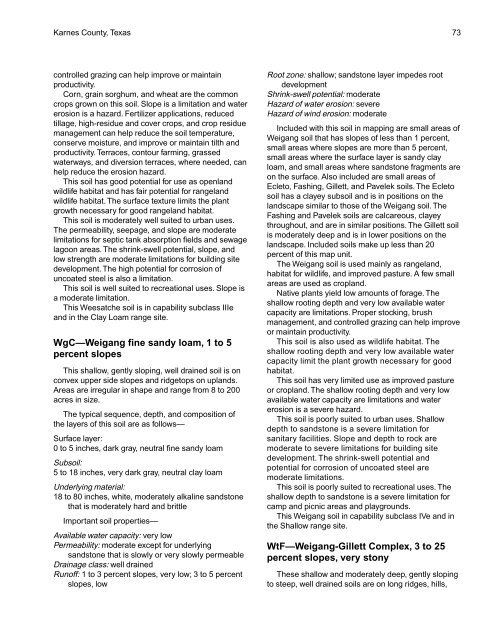Soil Survey of Karnes County, Texas - Soil Data Mart - US ...
Soil Survey of Karnes County, Texas - Soil Data Mart - US ...
Soil Survey of Karnes County, Texas - Soil Data Mart - US ...
You also want an ePaper? Increase the reach of your titles
YUMPU automatically turns print PDFs into web optimized ePapers that Google loves.
<strong>Karnes</strong> <strong>County</strong>, <strong>Texas</strong> 73<br />
controlled grazing can help improve or maintain<br />
productivity.<br />
Corn, grain sorghum, and wheat are the common<br />
crops grown on this soil. Slope is a limitation and water<br />
erosion is a hazard. Fertilizer applications, reduced<br />
tillage, high-residue and cover crops, and crop residue<br />
management can help reduce the soil temperature,<br />
conserve moisture, and improve or maintain tilth and<br />
productivity. Terraces, contour farming, grassed<br />
waterways, and diversion terraces, where needed, can<br />
help reduce the erosion hazard.<br />
This soil has good potential for use as openland<br />
wildlife habitat and has fair potential for rangeland<br />
wildlife habitat. The surface texture limits the plant<br />
growth necessary for good rangeland habitat.<br />
This soil is moderately well suited to urban uses.<br />
The permeability, seepage, and slope are moderate<br />
limitations for septic tank absorption fields and sewage<br />
lagoon areas. The shrink-swell potential, slope, and<br />
low strength are moderate limitations for building site<br />
development. The high potential for corrosion <strong>of</strong><br />
uncoated steel is also a limitation.<br />
This soil is well suited to recreational uses. Slope is<br />
a moderate limitation.<br />
This Weesatche soil is in capability subclass IIIe<br />
and in the Clay Loam range site.<br />
WgC—Weigang fine sandy loam, 1 to 5<br />
percent slopes<br />
This shallow, gently sloping, well drained soil is on<br />
convex upper side slopes and ridgetops on uplands.<br />
Areas are irregular in shape and range from 8 to 200<br />
acres in size.<br />
The typical sequence, depth, and composition <strong>of</strong><br />
the layers <strong>of</strong> this soil are as follows—<br />
Surface layer:<br />
0 to 5 inches, dark gray, neutral fine sandy loam<br />
Subsoil:<br />
5 to 18 inches, very dark gray, neutral clay loam<br />
Underlying material:<br />
18 to 80 inches, white, moderately alkaline sandstone<br />
that is moderately hard and brittle<br />
Important soil properties—<br />
Available water capacity: very low<br />
Permeability: moderate except for underlying<br />
sandstone that is slowly or very slowly permeable<br />
Drainage class: well drained<br />
Run<strong>of</strong>f: 1 to 3 percent slopes, very low; 3 to 5 percent<br />
slopes, low<br />
Root zone: shallow; sandstone layer impedes root<br />
development<br />
Shrink-swell potential: moderate<br />
Hazard <strong>of</strong> water erosion: severe<br />
Hazard <strong>of</strong> wind erosion: moderate<br />
Included with this soil in mapping are small areas <strong>of</strong><br />
Weigang soil that has slopes <strong>of</strong> less than 1 percent,<br />
small areas where slopes are more than 5 percent,<br />
small areas where the surface layer is sandy clay<br />
loam, and small areas where sandstone fragments are<br />
on the surface. Also included are small areas <strong>of</strong><br />
Ecleto, Fashing, Gillett, and Pavelek soils. The Ecleto<br />
soil has a clayey subsoil and is in positions on the<br />
landscape similar to those <strong>of</strong> the Weigang soil. The<br />
Fashing and Pavelek soils are calcareous, clayey<br />
throughout, and are in similar positions. The Gillett soil<br />
is moderately deep and is in lower positions on the<br />
landscape. Included soils make up less than 20<br />
percent <strong>of</strong> this map unit.<br />
The Weigang soil is used mainly as rangeland,<br />
habitat for wildlife, and improved pasture. A few small<br />
areas are used as cropland.<br />
Native plants yield low amounts <strong>of</strong> forage. The<br />
shallow rooting depth and very low available water<br />
capacity are limitations. Proper stocking, brush<br />
management, and controlled grazing can help improve<br />
or maintain productivity.<br />
This soil is also used as wildlife habitat. The<br />
shallow rooting depth and very low available water<br />
capacity limit the plant growth necessary for good<br />
habitat.<br />
This soil has very limited use as improved pasture<br />
or cropland. The shallow rooting depth and very low<br />
available water capacity are limitations and water<br />
erosion is a severe hazard.<br />
This soil is poorly suited to urban uses. Shallow<br />
depth to sandstone is a severe limitation for<br />
sanitary facilities. Slope and depth to rock are<br />
moderate to severe limitations for building site<br />
development. The shrink-swell potential and<br />
potential for corrosion <strong>of</strong> uncoated steel are<br />
moderate limitations.<br />
This soil is poorly suited to recreational uses. The<br />
shallow depth to sandstone is a severe limitation for<br />
camp and picnic areas and playgrounds.<br />
This Weigang soil in capability subclass IVe and in<br />
the Shallow range site.<br />
WtF—Weigang-Gillett Complex, 3 to 25<br />
percent slopes, very stony<br />
These shallow and moderately deep, gently sloping<br />
to steep, well drained soils are on long ridges, hills,
















